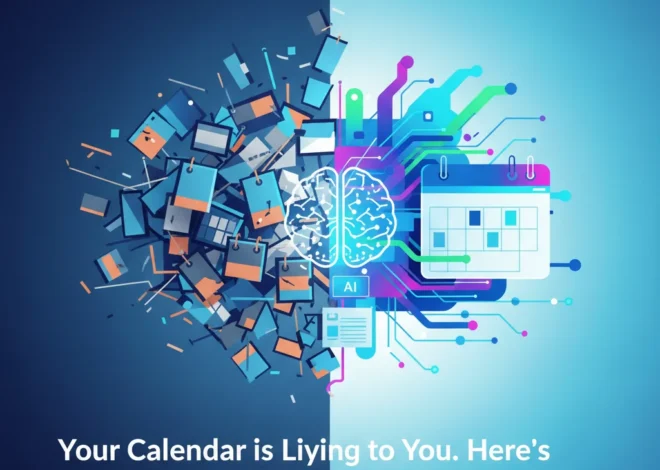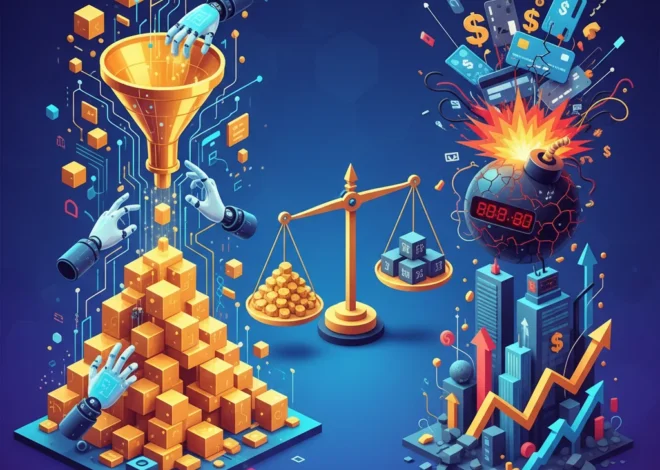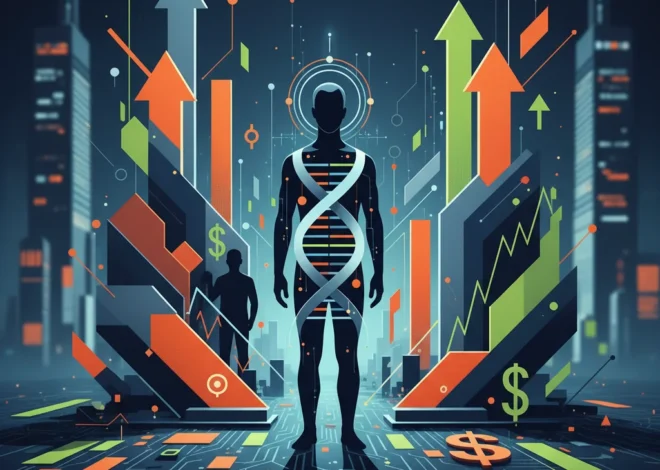
AI’s ‘Fried Chicken’ Moment: Are We in a Bubble or a Revolution?
There’s a brilliant, if terrifyingly brief, article in the Financial Times titled, “The AI bubble has reached its ‘fried chicken’ phase.” The entire content of the piece? Two words: “This is fine.”
For those fluent in internet culture, the reference is immediately clear. It conjures the image of the famous meme: a cartoon dog sitting in a burning room, smiling, and reassuring himself that everything is perfectly okay as flames engulf him. It’s a powerful metaphor for willful ignorance in the face of impending chaos. The title itself, however, is a deeper historical cut—a callback to the most manic phase of the dot-com bubble.
So, what exactly is the “fried chicken” phase, and are we really living through it again with artificial intelligence? Let’s peel back the layers of hype, explore the parallels to the past, and figure out if we’re building the future or just sitting in a burning room, pretending not to smell the smoke.
A Taste of History: What the Dot-Com Bubble’s ‘Fried Chicken’ Phase Can Teach Us
To understand today, we have to travel back to 1999. The internet was the new frontier, a digital gold rush promising to change everything. Venture capital flowed like water, and companies were going public with little more than a business plan and a “.com” at the end of their name.
The “fried chicken” phase refers to the peak of this irrational exuberance. The story, now a piece of tech folklore, goes that any company—no matter how unrelated to technology—could see its stock price skyrocket simply by associating itself with the internet. A brick-and-mortar fried chicken chain could rebrand as “e-Chicken.com” and watch investors pile in. The brand association became more valuable than the business model, the product, or the revenue.
It was a time when:
- Hype outpaced reality: The promise of the internet was real, but the timeline for profitability was wildly overestimated.
- Valuations detached from fundamentals: Companies were valued on “eyeballs” and “potential,” not on pesky details like profit and loss.
- FOMO (Fear Of Missing Out) drove investment: Everyone from institutional funds to retail investors was terrified of missing the next Amazon, leading to a herd mentality that inflated the bubble to epic proportions.
When the bubble burst in 2000-2001, it was brutal. Companies like Pets.com and Webvan, once darlings of Wall Street, evaporated overnight. Yet, from the ashes rose the giants that define our modern world: Amazon, Google, and eBay. The revolution was real; the initial frenzy was not sustainable. This is the crucial lesson: a bubble doesn’t necessarily mean the underlying technology is a fraud. It often means the hype has simply run years, or even decades, ahead of the practical reality.
The AI Menu Today: Spotting the Signs of a Frothy Market
Fast forward to today. The parallels are impossible to ignore. Every company, from software startups to global conglomerates, is scrambling to rebrand itself as an “AI company.” The term AI is being sprinkled on everything like a magic seasoning that instantly increases value.
Here’s how the “fried chicken” phase is manifesting in the world of machine learning and generative AI:
- The “.AI” Rebranding: Just as “.com” was the suffix of the 90s, “.ai” is the domain of the 2020s. Startups are pivoting their entire marketing strategy to highlight any semblance of automation or data analysis as “AI-powered.” An HR platform becomes an “AI-driven talent optimization solution.” A note-taking app is now a “generative AI knowledge management system.”
- The Funding Frenzy: The venture capital world is pouring unprecedented sums into AI startups. According to a Crunchbase report, AI-related companies accounted for more than a third of all venture funding in early 2024. We’re seeing pre-product companies raise hundreds of millions of dollars at multi-billion dollar valuations based on the pedigree of their founding team and the promise of their vision.
- The Stock Market Reaction: The public markets are even more frantic. Nvidia, the company making the essential “picks and shovels” (GPUs) for the AI gold rush, has seen its valuation soar to trillions of dollars. Any company that merely mentions “AI” on an earnings call is often rewarded with a significant stock bump, regardless of how deep or superficial the integration is.
To put it in perspective, let’s compare the two eras. The patterns are eerily similar, though the technology and speed have changed dramatically.
| Indicator | The Dot-Com Era (c. 1999) | The AI Era (c. 2024) |
|---|---|---|
| Rebranding Frenzy | Adding “.com” to company names. Ex: A fried chicken shop becomes “e-Chicken.com”. | Adding “AI” to products/descriptions. Ex: A simple scheduling tool becomes an “AI-powered productivity platform”. |
| Key Infrastructure Play | Cisco, Sun Microsystems (building the “pipes” of the internet). | Nvidia, AMD (building the GPUs, the “brains” of AI). |
| Valuation Metrics | “Eyeballs,” “stickiness,” clicks. Revenue and profit were secondary. | “Compute access,” “parameter count,” talent acquisition. Profitability is often a distant goal. |
| Media Narrative | “The internet changes everything.” Daily headlines of teenage millionaires. | “AI changes everything.” Constant coverage of AGI and superhuman intelligence. |
The Pardon That Shook Silicon Valley: What Trump's Clemency for CZ Means for the Future of Tech
On the other hand, you have the application layer. This is where the “fried chicken” stands are setting up shop. It’s a chaotic, frothy, and often confusing space where thousands of new SaaS companies are trying to build a business by wrapping a simple UI around an OpenAI API call. Many of these will fail, and that’s okay. That’s how market cycles work. The danger isn’t that they will fail, but that their failure could trigger a broader “AI winter” or a market correction that temporarily punishes the truly innovative companies alongside the pretenders. The key is to differentiate between the chefs building new kitchens and those just reheating frozen chicken.
But This Time It’s Different… Or Is It?
The “this time it’s different” argument is famously the four most dangerous words in investing. However, there are fundamental differences between the dot-com era and the current AI boom that are worth considering.
First, the innovation is immediately useful. In 1999, the utility of the internet for the average person was still limited. Dial-up was slow, e-commerce was clunky, and the killer apps hadn’t been built yet. Today, generative AI tools are already producing tangible value. Developers are using AI assistants for programming to write code faster, marketers are generating ad copy in seconds, and businesses are using automation to streamline complex workflows. The time from invention to utility is dramatically shorter.
Second, the infrastructure is mature. The dot-com boom was built on a nascent internet infrastructure. The AI boom is built on the back of the global cloud computing ecosystem, which provides scalable, on-demand compute power. This allows AI companies to scale far more quickly and cheaply than their dot-com predecessors.
Finally, the path to monetization is clearer. Many AI capabilities are being integrated into existing, profitable software products. Microsoft 365 Copilot, Adobe Firefly, and Google’s AI features are being sold to millions of existing customers. This B2B and SaaS integration provides a much more stable revenue foundation than the B2C advertising models that so many dot-com companies relied on.
The AI Longevity Paradox: A Longer Life for the Few, or a Shorter One for the Many?
How to Survive the Hype: A Guide for the Savvy and the Skeptical
So, how should we navigate this environment? Whether you’re a developer, an entrepreneur, or just a curious observer, the key is to separate the signal from the noise.
For Developers & Tech Professionals
Focus on foundational skills. While learning to use the latest API is valuable, the real, long-term career security comes from understanding the fundamentals of machine learning, data science, and the underlying architecture. Strong skills in programming, algorithms, and systems design will always be in demand, long after the current wave of “AI wrapper” startups has crested. Also, consider specializing in areas like AI ethics and cybersecurity, which are becoming critically important.
For Entrepreneurs & Startups
Don’t be an “AI company”; be a problem-solving company that uses AI. The most durable businesses will be those that apply AI to solve a real, painful customer problem in a way that is 10x better than the alternative. Ask yourself: what is my defensible moat? If your entire product can be replicated in a weekend with a few API calls, you don’t have a business, you have a feature. Focus on unique data, proprietary workflows, or a deep understanding of a niche industry.
For Investors & The General Public
Be a critical consumer. When you see a product advertised as “AI-powered,” ask “how?” Does the AI fundamentally enable a new capability, or is it just a marketing buzzword for a simple algorithm? Look for companies with strong product-market fit, a clear path to profitability, and a genuine technological advantage. The same principles of sound investing and business analysis still apply, no matter how exciting the technology is.
Conclusion: The Fire is Real, But So is the Hype
The FT’s “This is fine” commentary is a sharp and witty observation. We are in a period of intense, perhaps irrational, excitement around artificial intelligence. The smell of “fried chicken” is in the air, as countless companies rush to cash in on the hype.
But unlike the dog in the meme, we don’t have to sit here and pretend the fire isn’t real. The fire, in this case, is the revolutionary potential of AI—a force that will reshape industries and redefine how we work and create. The challenge is to respect the fire without getting burned by the hype. A correction will likely come for the frothiest parts of the market. Many AI-branded “fried chicken” stands will close down. But the companies building real, durable, and transformative technology will survive the heat. They will be the ones to emerge from the smoke, ready to build the next era of software and innovation.
The Automation Paradox: Deconstructing the AWS Outage That Shook the Internet


